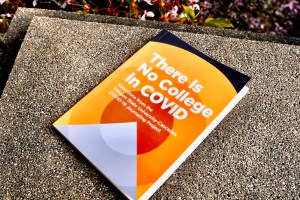This week I have learned a few things:
1. I now completely understand why so many people drop out of college.
2. Insulin is as cheap as water. (I’m being sarcastic.)
3. My boyfriend gives the best hugs.
4. I can’t wait to become a teacher and help mold little brains.
5. Weighted blankets and lots of ice cream will get me through college.
Anya R., October 11, 2020

There Is No College in COVID is an unadorned compilation of twice-weekly journal entries by first-term, first-year students in Jenna Goldsmith’s Fall ’20 ALS 199 U-Engage class at OSU-Cascades. The book is equal parts inspiring, reflective, heartening, and heartbreaking. It’s a precious first-person chronicle of students’ lives as they entered college six months after the pandemic began.
You can read this book in an hour or two, then spend months sorting through the thoughts and feelings that the powerful, honest writing of these students evokes about a long ordeal that we, too, lived through, each in our own way.
Jenna Goldsmith is a poet and Assistant Director of the Women’s, Gender, and Sexuality Studies Program at Illinois State University. She was a Senior Instructor of writing at OSU-Cascades at the time of the COVID-19 Journaling Project. Dr. Goldsmith graciously agreed to answer our questions and share her perspectives about the book. She identified the student quotes used in this post as some of her favorite passages.
CTL: What do you think instructors might learn from this book that would be applicable to their roles in teaching, advising, and nurturing college students?
JG: I think there are two main takeaways from this book. First, the journal entries reflect a complex swath of reactions to being a college student during the pandemic. As educators, I believe we benefit from reading those responses, as it’s sometimes easy to become numb to our students’ experiences, or forget about how impactful this has been on their lives.
Also, the book reflects an effort to think creatively about what students can produce in a course. As noted in the Introduction of the book, the course this book came out of looked very different before the pandemic. The pandemic caused me to reconceptualize the course, and in a way, opened up the possibility of what we could do in the course. I encourage instructors to think hard about how they can infuse students’ lived experience during these unprecedented times in the courses they are teaching.
CTL: What are the lasting messages about teaching and learning that you find in these Fall ’20 writings of your students?
JG: I hope that instructors will continue to take care of themselves, just as they would instruct their students to take care of themselves. In this book, we witness a lot of confusion, a lot of heartbreak, and a lot of uncertainty about the future. These are not just feelings students have in higher ed—instructors are right alongside them in that. Find common ground with students when it comes to these challenging times, and see where there is overlap in experience.
I found that giving students an academic space to reflect allowed them some relief in other areas of their lives. At the end of the term, they voiced their appreciation for the term-long journaling assignment, noting in particular how it added to their self-care routine and a more positive mental state.
Though the OSU grading system doesn’t recognize A+ as a final grade, There Is No College in COVID has earned one. This book will continue to inform teaching and coping with great challenges for a long time to come.
This pandemic really made me enjoy the little details: the smell of cookies when they are baking in the oven; the cat stretched out baking in the sun; the warmth of the fire in the woodstove; the sound of the rain on the roof. I am a homebody but this virus has led to a whole new level of comfort, and it is amazing. Sometimes we just have to focus on the positive things and not let our worries take over our lives. We need to pay attention to what’s happening around us.
Elliana B., November 22, 2020

In the spirit of There Is No College in COVID, you are invited to share your perspectives on the pandemic through CTL’s Bright Side Project, which is compiling the stories of faculty, staff, and students for an online public collection. Would you like to share your thoughts on how you kept teaching amidst the challenges of the past two years? What worked well? What skills have you gained and what have you learned about yourself that you will carry forward?
The There Is No College in COVID project was supported by a grant from the OSU Women’s Giving Circle, and all proceeds from sale of the book go toward OSU-Cascades scholarships.

Leave a Reply